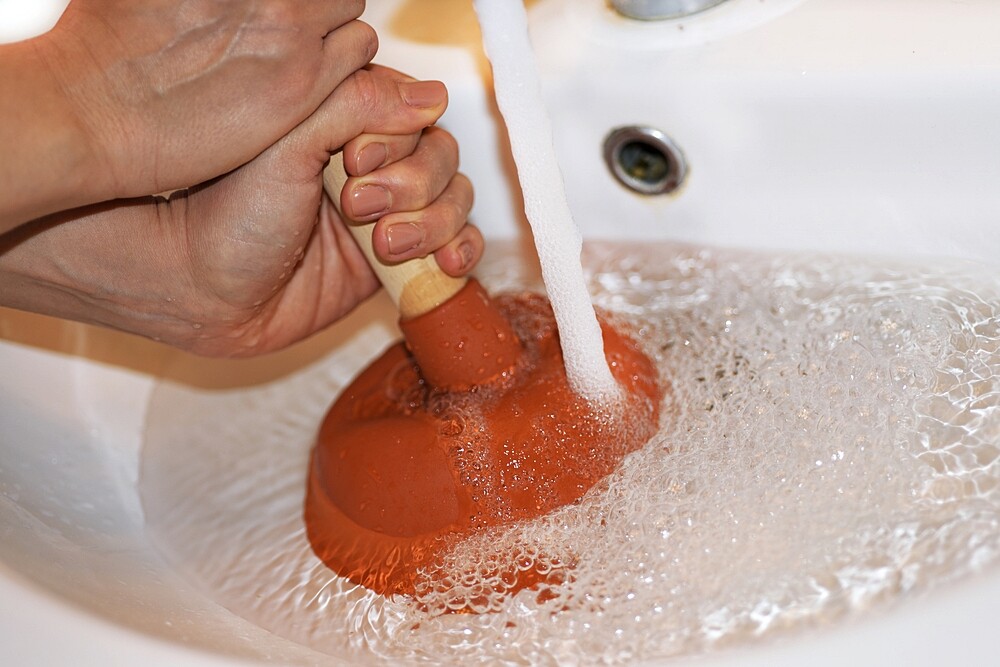If the drain in the bathroom or kitchen is clogged, aggressive chemical drain cleaners are not always necessary. Natural household remedies help to clean the drain.
Drainage blockages are usually caused by fat deposits (for example, soap residues) and hair. If the drain pipe is blocked and a plumber is hired, it can be quite expensive.
In order to save the costs for such a pipe cleaning, there are some tips and tricks that clean the drain without much effort and without chemicals.
Cleaning the drain: These household remedies help
- Baking powder and vinegar: Baking soda is the household remedy par excellence, and very effective especially for blocked drains. In the video above you can see how to use baking powder and vinegar to get a free drain again in no time. By the way: Instead of baking powder you can also use baking soda together with vinegar as pipe cleaner.
- Plunger: With a suction bell – also known as rubber bell, plunger or plunger – clogged drains can be cleaned very easily. Hot water should be poured into the relevant drain before the plunger is used. If there is an overflow, it should be covered with a damp cloth. Place the rubber bell on the drain and cover it completely if possible. Then you can start: Pulling the wooden handle up and down quickly creates a suction in the drain, which releases the blockage.
- Plastic bottle: If the shower drain or sink drain pipe is blocked, a plastic bottle can also help. If you do not have a plunger at hand, you can use it to clean the blocked drain in a similar way. However, the opening of the bottle must be large enough to cover the drain. This is the way to do it: Fill the bottle with hot water and press it down on the drain. Squeeze the wrong one again and again to create the same suction effect as with the plunger.
- Skewer: Hair often blocks the drain from the sink or shower. In the event of a blockage, however, it does not always have to be chemical pipe cleaner. Simply insert a wooden skewer into the drain and turn it with your fingers. The hairs are already wrapped around the skewer.
Removing a clogged drain for advanced users
Cleaning spiral
The pipe spiral requires manual skill and is mostly used by plumbers. There is a risk of damaging the pipe more than simply cleaning the clogged drain.Carefully guide the cleaning spiral into the drain and through the siphon to the downpipe.
- Carefully guide the cleaning spiral into the drain and through the siphon to the downpipe.
- Turn the crank and apply a slight downward pressure.
- If you feel resistance, the spiral should be pulled up and then pushed back in.
- After cranking, water should always be poured in and checked to see if it can run off again.
Wiring Brush
If the water in the sink no longer runs off, the blockage is usually located directly in the siphon. It is therefore advisable to remove the pipe under the basin and clean it with a wire brush. To disassemble it into its individual parts, we recommend using a pipe wrench. Before the siphon is reassembled, a seal check should be carried out and, if necessary, a seal replacement should be initiated.
Prevent clogging of drains
“If the drain is really clogged, even a strong drain cleaner from the drugstore usually doesn’t help anymore and the plumber has to do it,” says household expert Yvonne Willicks. To prevent the drain from clogging in the first place, we have to take preventive measures.
And it works like this: once a week, pour a packet of baking powder or a tablespoon of soda into the sink. Then rinse it with a little water and let it soak in well. With this trick we say goodbye to clogged drains and nasty smells for good!

